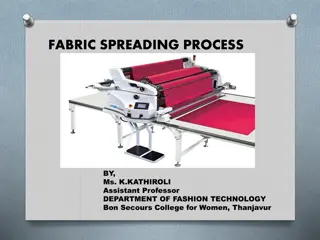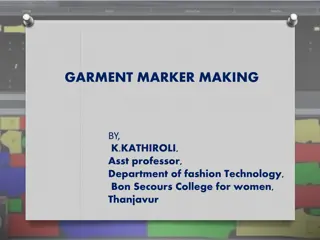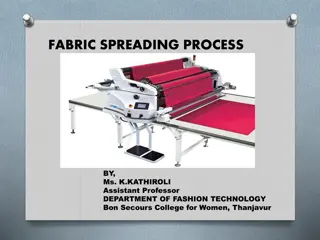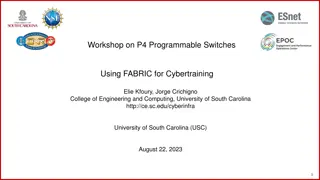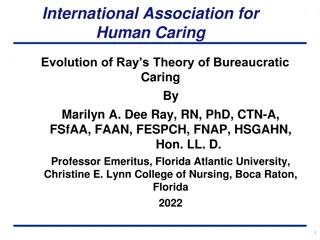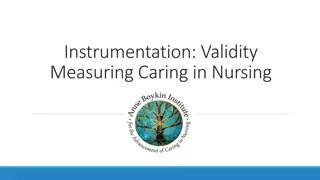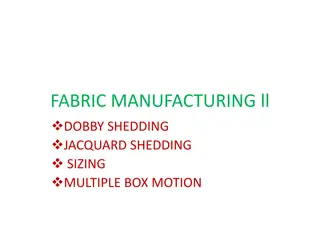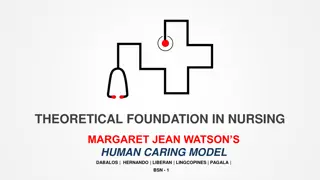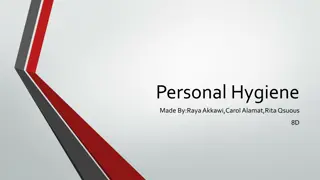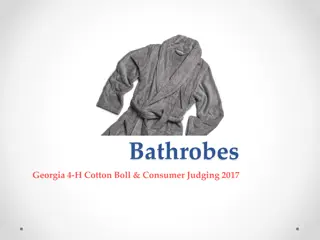Practical Guide to Fabric Care: Caring for Clothes
This chapter focuses on fabric care and clothing maintenance, covering topics such as understanding care labeling, preparing clothes for laundering, using washing machines effectively, stain removal techniques, selecting detergents, utilizing dryers and irons correctly, and practical application of care knowledge to extend the lifespan of garments. Learning about textile care, caring for clothes promptly, handling care labels, and the importance of care labels in making informed decisions while purchasing clothing are essential aspects discussed.
Download Presentation

Please find below an Image/Link to download the presentation.
The content on the website is provided AS IS for your information and personal use only. It may not be sold, licensed, or shared on other websites without obtaining consent from the author. Download presentation by click this link. If you encounter any issues during the download, it is possible that the publisher has removed the file from their server.
E N D
Presentation Transcript
Chapter 28: Fabric Care Caring for Clothes
What I Will Learn To discuss how to care for clothing and household textiles To understand care labelling To prepare clothes and household textiles for laundering To use a washing machine To explain how to remove stains To choose detergents and conditioners To use a dryer and an iron correctly To apply this knowledge in a practical way
Textile Care Textiles get dirty and stain easily. It important to clean them before the dirt and stains become ingrained into the fabric, because then they are more difficult to remove. Clean clothes that are well cared for look better and last much longer, so it is important to learn about fabrics and how to care for them.
Caring for Clothes Clothes that are well looked after last longer and look better. Wash soiled or stained clothing as soon as you can. The longer they are left, the harder it will be to remove the stains and dirt. Hang clothes straight after use on shaped or padded hangers; close any zips and buttons. Fold knitwear and store it flat. Mend clothes before storing, e.g. fix hems, sew on buttons. Polish shoes and leather accessories to preserve them and keep them looking smart. Store clothes in a wardrobe or in drawers.
Care Labelling Care labels are found on most clothes and household items. Care labels may contain written instructions or symbols devised by the International Care Labelling Scheme. They can be on a woven or printed label that is sewn into a garment. Labels show the manufacturer s name, the size, fibre content and care information.
Why Are Care Labels Important? They help you make an informed decision when buying clothing. They provide useful information that can save you time and money. Your clothes last longer if you know how to care for them properly. A garment that can only be dry cleaned could end up being very costly. Care labels tell you what fibres are in garments so if you have an allergic reaction to certain fibres (e.g. wool), you can avoid them.
Care Label Law Clothing and other textile products for sale in the EU must be labelled with the fibre content, e.g. 100% cotton or 50% wool, 50% acrylic . Manufacturers do not have to put the country of origin or any wash symbols on the care label although most do.
Care Labelling Instructions Many of the care label instructions are in symbols. The International Care Labelling Scheme has five basic symbols: A washtub showing the washing temperature to be used A triangle which indicates if chlorine bleach can be used
Care Labelling Instructions (continued) A square containing drying instructions An iron with dots to indicate the temperature to be used A circle for dry cleaning instructions for the dry cleaner
Drying Symbols Tumble dry Dry flat Line dry Do not tumble dry Drip dry
Ironing Symbols Hot iron Cool iron Do not iron Warm iron
Bleaching Symbols Bleach may be used Do not bleach
Dry Cleaning Symbols Do not dry clean
Washing Instructions There are three factors to consider when machine washing textiles: 1. Water temperature:Written inside the washtub symbol. 2. Wash action: How fast the machine moves the clothes around during the cycle. The bar symbol under the washtub tells you the correct wash action and spin length for the item you are washing. No bar indicates maximum washing action and spin One bar indicates medium washing action and a short spin A broken bar indicates minimum washing action or a wool cycle spin 3. Spin length: Spin (full) or short spin.
Washing Symbols Symbol Machine wash Hand wash Fabric Maximum wash in cotton cycle Hand hot (50 C) or boil. Spin or wring White cotton and linen items without special finishes Maximum wash in cotton cycle Hand hot (50 C) or boil. Spin or wring Cotton, linen or viscose items without special finishes where colours are fast at 60 C
Washing Symbols (continued) Symbol Machine wash Hand wash Fabric Medium wash in synthetic cycle Hand hot. Cold rinse. Short spin or damp dry Polyester/cotton mixtures, nylon polyester, cotton and viscose items with special finishes, cotton/acrylic mixtures Maximum wash in cotton cycle Warm. Spin or wring Cotton, linen or viscose items where colours are fast at 40 C but not at 60 C
Washing Symbols (continued) Symbol Machine wash Hand wash Fabric Medium wash in synthetic cycle Warm. Cold rinse. Short spin. Do not hand wring Acrylics, acetate and triacetate, including mixtures with wool; polyester/wool blends Minimum wash in wool cycle Warm. Do not rub. Spin. Do not hand wring Wool, wool blends, silk
Washing Symbols Symbol Machine wash Hand wash Fabric Hand wash only See item care label for washing instructions Items that must not be machine washed; glass fibre fabrics and some pleated fabrics Do not wash Do not wash Items that cannot be washed: see item care label for cleaning instructions
Stain Removal Most stains can be removed from fabrics by washing. However, some stains can be difficult to remove so another method of stain removal treatment will depend on: The type of stain The type of fibre If the fabric is washable or not
Guidelines for Removing Stains Guidelines for Removing Stains Act quickly or the stain will set. Remove excess by blotting gently, but do not rub. Check the care label to see if item is washable. Remove stains before washing. Always start with mild treatments, like soaking in cold water. Always test commercial stain removers on a part of garment that will not be seen, e.g. inside seam or hem. Try Green stain removers first.
Guide to Stain Removal Did you know that many household stains can be removed with other household items? Get rid of this Using this Get rid of this Get rid of this
Guide to Stain Removal (continued) Get rid of this Using this Get rid of this Using this
Guide to Stain Removal (continued) Get rid of this Using this After treating the stain, wash according to the instructions on the care label.
Commercial Stain Remover If you need to use a commercial stain remover, it is important to: Follow the instructions on the product. Use a well-ventilated room, as many are dangerous to inhale. Use gloves and wash your hands. Not use it near flames. Store it upright, in a cool dry place, away from children (why?)
Stain Removal Activity Work in pairs for this activity. You have each been given fabrics with two different stains. Treat the stain using the green cleaners e.g. lemon, baking soda, vinegar to see which cleaner works best on which stains. Feed back your results to the class and have a discussion on stain removal. See Activity 28.7 in the TRB
Preparing a Wash 1. Repair any clothes that need mending. 2. Remove stubborn stains. 3. Close up zips and buttons. 4. Empty pockets. 5. Turn t-shirts and sweatshirts with ironed-on logos inside out (why?). 6. Sort clothes according to their colour and their care labels the colour in some clothes is colourfast, meaning it will not run. Other clothing has colours that are non- colourfast. These clothes need to be washed separately, as their colour will run into other clothing in the wash.
Delicate Fabrics Wash by hand Use a mild detergent Rinse twice Squeeze to remove excess water Roll in a towel to remove water Drip or dry flat
Detergents Detergents are available in powder, liquid, liquitab or tablet form. They are made from a mixture of chemicals including enzymes, bleaching agents, optical brighteners, and perfumes. Some have added conditioners. Types Functions Help remove dirt and grease Softens the water Reduces the surface tension so the fabric can get wet through Biological detergents, which contain enzymes that break down protein stains at low temperatures Detergents for delicate fibres Eco-friendly detergents
Detergent Research Activity Did you know that there are things we can do to make our laundry routines more eco-friendly? 1. Do some research to find out how to do laundry in an environmentally friendly manner. 2. Investigate eco-friendly detergents and compare the ingredients, cost and packaging information with another detergent on the market. 3. Present your findings to your classmates in a creative way.
Fabric Conditioners Fabric conditioners are added to the final rinse to: Reduce static electricity Soften clothes Give fabrics a pleasant smell Make ironing easier
Activity: Examination of Laundry Products 1. Working in pairs, examine the laundry product in front of you. 2. Complete the worksheet with the product information. 3. Feed back information to your class and discuss the environmental impact of various laundry products. See Activity 28.9 in the TRB
Drying Clothes Clothes can be dried on a clothes line outside, on a clothes horse inside or by using a tumble dryer. (Which method do you think is best? Justify your answer.) Line drying costs nothing and clothes remain soft and smell fresh. It is the most eco-friendly method of drying. However, Irish weather is not always suitable for drying outside. Clothes horses are used when the weather is bad but it causes condensation so the room must be well ventilated.
Drying Clothes (continued) A tumble dryer contains an element that heats the air coming into the machine. The clothes are rotated gently in the warm air and the moisture is removed through a vent in the wall, or is condensed from steam back into a water tank, which can be emptied. Tumble dryers are costly to run, but they remove wrinkles and reduce the need for ironing.
Ironing An iron contains a heating element that heats the shiny base plate. A thermostat controls the temperature, and a light turns off when the correct temperature is reached. Irons contain a small water tank that creates steam, which is released through the base, making it easier to remove creases. Check the care label and select the correct heat setting. Iron clothes while they are still slightly damp or use a steam iron for a smoother finish. Iron some items inside out (why?). Iron carefully to avoid creasing.
Quick Quiz 1. Give three reasons why care labels are attached to textiles. 2. Sketch and describe a care label for: (a) a wool jumper and (b) a pair of denim jeans. 3. Suggest a stain remover for each of these stains: (a) blood, (b) egg and (c) ink. 4. What guidelines should be followed when washing and drying a linen dress? 5. List four guidelines to follow when ironing clothes.


